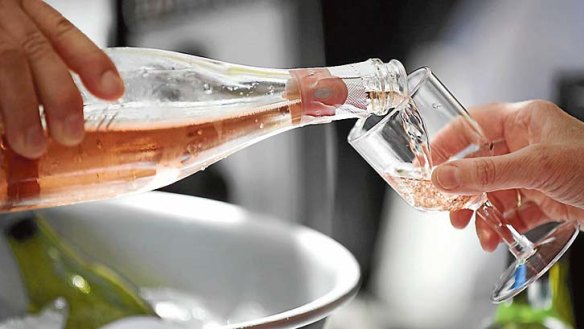'Cheap plonk' is suddenly coming up roses
Rosé wine is food-friendly, perfect for a warm day and more popular in summer than its white wine counterparts in France. So why is this wine so maligned in Australia?

Rosé wines have a less than stellar reputation in Australia, placed in the lolly-water or "cheap plonk" category. And not without good cause.
But change is afoot, with a growing number of winemakers and sommeliers determined to change both the quality of local rosé and its reputation.
“It can be just as good and give as much pleasure as red wine [but] we have sometimes a hard time finding good rosés,” says Michael Engelmann, head sommelier at Sydney's Rockpool Bar and Grill.
“A lot of it is cheap plonk – it's poorly made, it's too sweet and there's nothing to it except the colour. It's more grape juice than finished wine.”
Until recently, winemakers often produced rosé out of what was essentially the byproduct of other wines, says former-chef-turned-winemaker-and-sommelier Adam Foster of Syrahmi and Foster e Rocco in Victoria. This method of making rosé, known as "saignee" (meaning "bled" in French), involves bleeding off and then fermenting the free-run juice from red wine grapes.
“Not much thought goes into it and they don't really care about it," Foster says. "In essence they're making the wine for free anyway.”
Foster is one of a small but rapidly growing number of Australian winemakers working to build a reputation for drier, purpose-made rosés. He makes his best-selling Foster e Rocco Rosé using the skin-contact method favoured by European producers. This involves pressing red grapes and leaving the skins in contact with the juice for a short time.
“About five or six years ago we didn't have anything like they have in Europe. They have drier, more savoury rosés, which are normally quite low in colour and actually taste of the grape variety they're made with,” he says.
“When you don't use the saignee method you get more flavour. We buy the grapes, press them and throw them out.”
The popularity of this style of wine in Spain and the south of France speaks volumes for the style, says Trish Barry, a spokeswoman for the Rosé Revolution – a campaign by winemakers to promote drier, more textured rosé in Australia.
“In France, more rosé is consumed during the summer months than white wine,” she says. And even though Australian rosé consumption is nowhere near overtaking white wine consumption, its popularity is growing rapidly.
“Over the past 12 months, rosé wine sales over $15 grew at 29 per cent – twice that of the total bottled red or white in the same price bracket,” Barry says.
"Over the $15 mark you start to see more purpose-made [rosé] wines and that's where the growth is."
Which makes sense because drier, purpose-made rosés are more food-friendly, says Dan Sharp, head sommelier at the Merivale Group's Est. restaurant in Sydney.
“With purpose-made rosés, the grapes are picked a lot earlier because the skins and tannins don't have to be as ripe. Picking earlier gives the wine real freshness, which is what I look for in a rosé – fresh, crisp, dry aromatics,” he says.
“Picking early also lets the grape retain its natural acidity and gives the wine more texture and structure, which makes it better to pair with food.”
In fact, the best thing about this kind of rosé is its versatility, he says. “It's one of the only wines that pairs well with soup. As you can imagine it's very hard to match a liquid with a liquid.”
Rosé is also a great accompaniment to spicy food, which is notoriously difficult to match with wine, Rockpool's Engelmann says.
“It can tamper the heat of the dish and refresh the palate. Here at the restaurant we have a tomato-based seafood stew with a bit of spice, and rosé goes terrific with that.”
Pairing suggestions
Salad
Antipasto
Tapas
Seafood paella
Grilled tuna steak
Asian food and spicy food, e.g. Thai duck curry
Charcuterie and light meats
Barbecued prawns
Tangy and earthy cheeses, e.g. sheep's cheese
Tasting notes
Neil Prentice, winemaker and sommelier, Moondarra Wines, Victoria
TarraWarra Estate Pinot Noir Rosé
“The Tarrawarra is fruitful and crisp with bright sour cherry flavours. I drank it just last week with a cold salad made with Peking Duck.”
Foster e Rocco Sangiovese Rosé
“I serve the Foster e Rocco at ChinChin [restaurant in Melbourne]. It is a delight with the sweet/sour/salt/bitter of Thai food. The flavours of the Foster e Rocco are pretty floral and can handle the spice really well.”
Arrivo Rosato di Nebbiolo Rosé
“Nebbiolo rosé has pronounced acidity and a bit of tannin which are features of this variety. I love it with charcuterie on a summer evening.”
Domaine Tempier Bandol Rosé
“I enjoy Bandol rosé more than grenache-based Provence-style rosés. These wines are beautifully dry and savoury, without the forward fruit of pinot noir, grenache or sangiovese.”
Dan Sharp, head sommelier, Est. restaurant, Sydney
Charles Melton Rosé of Virginia Rosé
“They've been making it for 25 years, mostly from grenache in the Barossa Valley. It has a real vibrancy and elegance. It's probably one of the best in Australia.”
Foster e Rocco Sangiovese Rosé
“Another wine in that European style – very pale, dry, quite spicy. Fresh, light, barrel-fermented rosé. The natural fermentation technique, which means they use the natural yeast instead of cultured yeast – and a longer, slower fermentation … adds texture and roundness to the wine.”
Sutton Grange Estate Rosé
“Very, very pale rosé made from syrah. It almost doesn't look like a rosé.”